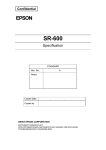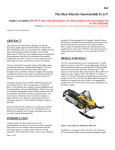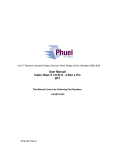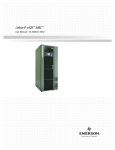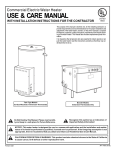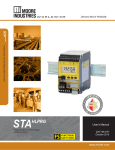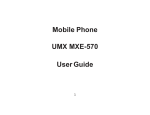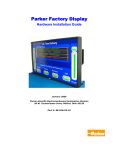Download Toshiba G8000 Series Power Supply User Manual
Transcript
Uninterruptible Power System (UPS) G8000 Series Installation Manual • REQUIREMENT S Read this operation manual carefully before installing the UPS. • Retain this manual with the UPS for easy reference when required. • This manual was written for the consulting engineer, architect, and electrical contractor. Document Number: 57490-000 February 2005 © TOSHIBA Corporation 2005 All Rights Reserved. Notice Please inform Toshiba Corporation or authorized representatives in case of inconsistencies, omissions, or questions. The instructions contained in this manual are not intended to cover all of the details or variations in equipment, or to provide for every possible contingency concerning installation, operation, or maintenance. Should further information be required or if problems arise which are not covered sufficiently contact your Toshiba sales office. The contents of this instruction manual shall not become a part of or modify any prior or existing agreement, commitment, or relationship. The sales contract contains the entire obligation of Toshiba International Corporation's UPS Division. The warranty contained in the contract between the parties is the sole warranty of Toshiba International Corporation's UPS Division and any statements contained herein do not create new warranties or modify the existing warranty. Any electrical or mechanical modifications to this equipment without prior written consent of Toshiba International Corporation will void all warranties and may void the UL/CUL listing. Unauthorized modifications can also result in personal injury, death, or destruction of the equipment. 1. Introduction This manual is intended to help implement safe and correct transportation, installation and wiring of the G8000 Series Uninterruptible Power System (hereafter referred to "UPS"). Before transportation, installation and wiring of the UPS, please read through all of the chapters. Above all, read the “General Safety Instructions,” “Important Safety Instructions,” “Safety Precautions” and “Installation Precautions” chapters, as these must be carefully read. Please make sure that you have a thorough understanding of the information in these 4 chapters. Personnel that will install the UPS should carefully read this manual before installation. Keep this manual close to the UPS so you can refer whenever necessary. Also, please read through the "Operation Manual." The Operation Manual describes the important instructions to be used during UPS operation. The manuals should remain together. 1 UNINTERRUPTIBLE POWER SUPPLY Complete the information below for the UPS system received. Unless otherwise specified, the warranty period for the UPS or UPS part is 36 months from the shipment date (see TIC bill of lading). Unless otherwise specified, the warranty period for a UPS battery is 24 months from the shipment date (see TIC bill of lading). Please complete the following information and retain for your records. Job Number: Model Number: Serial Number: Application: Shipment Date: Installation Date: Inspected By: 2 Manual’s Purpose and Scope This manual provides information on how to safely install, operate, and maintain your TIC power electronics product. This manual includes a section of general safety instructions that describes the warning labels and symbols that are used throughout the manual. Read the manual completely before installing, operating, or performing maintenance on this equipment. This manual and the accompanying drawings should be considered a permanent part of the equipment and should be readily available for reference and review. Dimensions shown in the manual are in metric and/or the English equivalent. Toshiba International Corporation reserves the right, without prior notice, to update information, make product changes, or to discontinue any product or service identified in this publication. TOSHIBA is a registered trademark of the Toshiba Corporation. All other product or trade references appearing in this manual are registered trademarks of their respective owners. Toshiba International Corporation (TIC) shall not be liable for direct, indirect, special, or consequential damages resulting from the use of the information contained within this manual. This manual is copyrighted. No part of this manual may be photocopied or reproduced in any form without the prior written consent of Toshiba International Corporation. © Copyright 2005 Toshiba International Corporation. All rights reserved. Printed in the U.S.A. Contacting Toshiba’s Support Center Customer Toshiba’s Customer Support Center can be contacted to obtain help in resolving any Uninterruptible Power Supply system problems that you may experience or to provide application information. The center is open from 8 a.m. to 5 p.m. (CST), Monday through Friday. The Support Center’s toll free number is US (800) 231-1412/Fax (713) 466-8773. You may also contact Toshiba by writing to: Toshiba International Corporation 13131 West Little York Road Houston, Texas 77041-9990 Attn: UPS Product Manager. For further information on Toshiba’s products and services, please visit our website at www.tic.toshiba.com. 3 2. General Safety Instructions DO NOT attempt to install, operate, maintain or dispose of this equipment until you have read and understood all of the product safety information and directions that are contained in this manual. Safety Alert Symbol The Safety Alert Symbol indicates that a potential personal injury hazard exists. The symbol is comprised of an equilateral triangle enclosing an exclamation mark. Signal Words Listed below are the signal words that are used throughout this manual followed by their descriptions and associated symbols. When the words DANGER, WARNING and CAUTION are used in this manual they will be followed by important safety information that must be carefully adhered to. The word DANGER preceded by the safety alert symbol indicates that an imminently hazardous situation exists that, if not avoided, will result in death or serious injury to personnel. DANGER The word WARNING in capital letters preceded by the safety alert symbol indicates that a potentially hazardous situation exists that, if not avoided, could result in death or serious injury to personnel. WARNING The word CAUTION in capital letters preceded by the safety alert symbol indicates that a potentially hazardous situation exists which, if not avoided, may result in minor or moderate injury. CAUTION/ATTENTION The word CAUTION or ATTENTION in capital letters without the safety alert symbol indicates a potentially hazardous situation exists which, if not avoided, may result in equipment and property damage. CAUTION 4 3. IMPORTANT SAFETY INSTRUCTIONS This instruction contains important instructions for the G8000 Series that should be followed during the installation, operation, and maintenance of the UPS systems. Please refer to the battery manufacturer’s instructions for details on operating and maintaining the batteries for each system. SAVE THESE INSTRUCTIONS The input and output of the UPS System are NOT equipped with an over-current protection device, or an output disconnection at the AC output. Therefore, a circuit breaker should be provided by the user between the UPS output and the critical load input. The minimum device ratings should be as follows: Capacity Rated Output Breaker Rating 125kVA 180kVA 250kVA 380V/220Vac 380V/220Vac 380V/220Vac 380V-250A 380V-350A 380V-500A Capacity 100kVA 150kVA 225kVA 300kVA Rated Output 480V/277Vac 480V/277Vac 480V/277Vac 480V/277Vac Breaker Rating 480V-150A 480V-225A 480V-350A 480V-450A Circuit breakers should be provided by the user between AC input (or Bypass input) and power sources. The minimum device ratings should be as follows: Capacity Rated Input Breaker Rating 125kVA 180kVA 250kVA 380V/220Vac 380V/220Vac 380V/220Vac 380V-250A 380V-350A 380V-500A Capacity 100kVA 150kVA 225kVA 300kVA Rated Input 480V/277Vac 480V/277Vac 480V/277Vac 480V/277Vac Breaker Rating 480V-150A 480V-225A 480V-350A 480V-450A The maximum ambient temperatures in which the UPS should be operated is 40°C (104°F) or 32°C (90°F) maximum if the battery system is to be subje cted to the same temperature. The nominal battery voltage for these models is 336Vdc for 125, 180 & 250kVA, and is 360Vdc for 100, 150, 225 & 300kVA. The nominal battery float voltage is 375Vdc for 125, 180 & 250kVA, and is 405Vdc for 100, 150, 225 & 300kVA. Only a certified service representative with battery experience should perform service on batteries. Keep unauthorized people away from batteries. Please refer to the battery manufacturer’s instruction when battery maintenance and/or replacement are scheduled. CAUTION Misuse of this equipment could result in personal injury and/or equipment damage. In no event will Toshiba Corporation be responsible or liable for either indirect or consequential damage or injury that may come from the use of this equipment. 5 4. Safety Precautions Application The UPS shall NOT be applied to support equipment (*) that could affect the human lives. Special considerations are required when applying this UPS to the equipment (**) that affect human safety and/or maintain public services. Be sure to contact/inform Toshiba if it is such a case. The application without special consideration may cause serious accidents. * ** • Medical operation room equipment • Life support equipment (artificial dialysis, incubators, etc.) • Toxic gas or smoke eliminators • Equipment that must be provided under fire laws, construction standards or other ordinances • Equipment equivalent to the above • Equipment to supervise or control airways, railways, roads, sea-lanes or other transportation. • Equipment in nuclear power plants. • Equipment to control communications. • Equipment equivalent/similar to the above mentioned. Disclaimer In no event will Toshiba Corporation be responsible or liable for either indirect or consequential damage or injury that may come from the use of this equipment. Any modifications without authorization by Toshiba could result in personal injuries, death or destruction of the UPS. Warning Labels Check Make sure all the warning labels are accordingly placed in the appropriate locations (see page 10~13). If a label is missing or illegible, contact Toshiba or authorized representatives. 6 General Terms WARNING Do NOT remove the rear/side panels. The parts inside carry energy-high current. That may result in electric shock, burns, personal injuries or UPS faults by removing these panels. PROHIBITED Do NOT modify the UPS, relocate after initial installation or replace parts by untrained personnel. Electrical shock, injury or UPS faults may result if non-certified technicians attempt to modify or relocate the UPS. Please contact Toshiba if you need UPS modifications or plan to move the UPS. PROHIBITED Transportation WARNING When moving the UPS using a crane, follow the specified work procedure (*) and keep the suspension wire angle within 60°°. Moving the UPS by any method other than that specified may cause personal injury by being crushed or trapped by the UPS when it falls or overturns. * As per specification in chapter 8. MANDATORY When moving the UPS, do NOT tilt the UPS more than 10°° from upright. Titling the UPS more than 10° may cause personal injury by being crushed or trapped by the UPS when it falls or overturns. MANDATORY 7 5. Installation Precautions Personnel WARNING Please have a certified/qualified electrician install the UPS per local and/or national electric codes. UPS faults or improper operation may occur if not installed properly per codes and the installation manual. MANDATORY Transportation/Unpacking CAUTION Do not transport, move, store, or place the UPS on its side. Excessive force applied from heavy objects inside may damage the UPS. PROHIBITED Avoid vibration or shock exceeding 0.5G to the UPS. Failing to observe this precaution may cause damage to the UPS. PROHIBITED When unpacking the unit, do not give a direct shock or impact to the UPS with a hammer or disassembling tool. It may cause damage to the UPS. PROHIBITED 8 Installation Environment CAUTION The UPS is to be installed in a controlled environment. Improper storage and installation environment may deteriorate insulation, shorten component life and cause malfunctions. Keep the installation environment per standard described in Table 5.1. MANDATORY Table 5.1 - UPS Installation Environment Standard No. Item Environment standard 1 Installation location Indoors 2 Ambient temperature Minimum temperature: 0°C, Maximum temperature: 40°C The average temperature over any 24-hour period must be in the range 5 to 35°C. 3 Relative humidity The relative humidity must be held between 30 and 90%. There must be no condensation due to temperature changes. 4 Altitude This equipment must not be applied at altitudes that exceed 1000m (3240 ft) above seal level. Vibrations in the installation environment must have frequencies either lower than 10 Hz, or higher than 20 Hz. 5 For vibrations under 10 Hz, the acceleration due to those vibrations must not exceed 0.5 G. Vibration and mechanical shock For vibrations over 20 Hz and under 50 Hz, the acceleration due to those vibrations must not exceed 0.5 G. For vibrations over 50 Hz and under 100 Hz, the total amplitude must not exceed 0.1 mm. 6 Dust Dust in the room where the UPS is installed must not exceed normal atmospheric dust levels. In particular, that dust must not include iron particles, oils or fats, or organic materials such as silicone. 7 Flammable gas There should be no flammable/explosive gas. Hydrogen sulfide (H2S) No more than 0.0001 PPM Sulfurous acid gas (SO2) No more than 0.05 PPM Chlorine gas (Cl2) No more than 0.002 PPM Ammonia gas (NH3) No more than 0.1 PPM Nitrous acid gas (NO2) No more than 0.02 PPM Nitrous oxides (NOx) No more than 0.02 PPM Ozone (O3) No more than 0.002 PPM Hydrochloric acid mist (HCl) No more than 0.1 mg/m 9 3 WARNING Keep the specified clearance around the UPS. Leaving no space makes it difficult to carry out maintenance, inspections, causes insufficient ventilation, and cooling leading to malfunctions. MANDATORY Keep the UPS room clean. Use a vacuum cleaner to clean the UPS. Also, Do NOT use silicon-contained waxes on the floor in the UPS room and in the related room as this may cause static electricity. MANDATORY Make sure the air vents on the front and top of the UPS are NOT blocked Blocking the vents will cause the temperature inside the UPS to rise and may result in fire or UPS faults. PROHIBITED Do NOT install the UPS close to a water source. It may cause electrical shock, UPS fault, or other accidents. PROHIBITED Please ask Toshiba or authorized representatives where the UPS and/or components are to be disposed. It is illegal to dispose of certain components without conforming to environmental regulation for industrial/commercial waste. MANDATORY 10 Wiring/Connection WARNING Be careful when connecting the UPS to the battery panel. A wrong connection may cause damage to the UPS, battery, or charger. Perform wiring and connections with correct polarity. PROHIBITED The tightening torque of screws must conform to the tightening criteria. Loose connections may cause fire due to heating. MANDATORY When making wire connections or handling the wires, observe the following precautions. • • Do not forcibly bend or pull the wires or damage the insulation. Do not place heavy objects on top of the UPS. Failing to observe this precaution may damage the insulation of the wires or may cause a fire or an electric shock hazard. MANDATORY Connect ground wire to the earth ground terminal only. A missing ground wire may cause an electrical shock hazard. Connecting to more than one ground may cause ground loop. See the chapter titled “Wiring” for wiring details. 11 MANDATORY Warning label check (1) Warning label locations on the UPS are shown in the Figures below. Please make sure these warning labels are placed in specified spots. (2) Please read all warning labels and understand what they mean. (3) Make sure warning labels are always legible. Do NOT allow the labels to be removed or covered. Locations of the Warning Labels (100/125 kVA). Figure 5.1 - 100/125kVA UPS exterior/interior showing warning labels. 12 Locations of the Warning Labels (150/180/225 kVA ). Figure 5.2 - 150/180/225kVA UPS exterior/interior showing warning labels. Figure 5.3 - 250/300kVA UPS exterior/interior showing warning labels. 13 The meanings of the following label symbols are as follows: 1) The lightning flash with arrowhead within a triangle is intended to tell the user or the service personnel that parts inside the product are a risk of electric shock to personnel. 2) The ground symbol in a blue circle is intended to tell the user or the service personnel the location of the equipment-grounding conductor. B A DANGER RISK OF ELECTRIC SHOCK CONTAINS PARTS NOT SERVICEABLE BY THE USER No user serviceable parts inside. This UPS receive power from more than one source-disconnection of all sources is required to de-energize this unit before servicing. Refer servicing to qualified service personnel. Dangerous electric charge may be stored in capacitors and associated circuitry. Intended for installation in a controlled environment. Wait at least five (5) minutes for power to dissipate then check voltage before servicing. Do not remove cover C for 125/180kVA USE COPPER CONDUCTORS ONLY REFER TO INSTRUCTION MANUAL REGARDING TIGHTENING TORQUE OF TERMINAL BLOCKS. 1 2 3 4 5 6 7 8 9 10 11 12 13 U V W U V W N U V W N - + 380V AC INPUT 380V BYPASS INPUT 380V AC OUTPUT 375V BATTERY C for 100/150/225kVA USE COPPER CONDUCTORS ONLY REFER TO INSTRUCTION MANUAL REGARDING TIGHTENING TORQUE OF TERMINAL BLOCKS. 1 2 3 4 5 6 7 8 9 10 11 12 13 U V W U V W N U V W N - + 480V AC INPUT 480V BYPASS INPUT 480V 400V AC OUTPUT BATTERY 14 D WARNING CRITICAL FUSE SIZING Incorrect fuse replacement size may result in fire or inadequate equipment protection. Replace only with same type and rating of fuse. E F DANGER DANGER RISK OF ELECTRIC SHOCK RISK OF ELECTRIC SHOCK OR ELECTRIC ENERGY-HIGH CURRENT LEVELS Capacitors stay charged after power has been shut off. Dangerous electric charge may be stored in capacitor and associated circuitry. Accidental contact with live parts can cause personal injury and death. Test before touching. Turn off and lock out all power sources. Wait at least five (5) minutes for power to dissipate then check voltage before servicing H The output ac circuit is considered as a separately derived source. If local codes require grounding of this circuit, use terminal (identify terminal) for bonding this circuit to the enclosure. Ground the enclosure to a suitable grounding electrode in accordance with local code requirements. G Grounding Electrode Terminal I J CAUTION CAUTION RISK OF ELECTRIC SHOCK 8A Heat Sink (IGBT) is not grounded. ( control power source switch ) Test before touching. Do not turn off while operating. K for 250kVA USE COPPER CONDUCTORS ONLY REFER TO INSTRUCTION MANUAL REGARDING TIGHTENING TORQUE OF TERMINAL BLOCKS. 1 2 3 4 5 6 7 8 9 10 11 12 U V W - + U V W N U V W 380V 375V 380V AC INPUT BATTERY BYPASS INPUT 380V AC OUTPUT K for 300kVA USE COPPER CONDUCTORS ONLY REFER TO INSTRUCTION MANUAL REGARDING TIGHTENING TORQUE OF TERMINAL BLOCKS. 1 2 3 4 5 6 7 8 9 10 11 12 U V W - + U V W N U V W 480V 400V 480V AC INPUT BATTERY BYPASS INPUT 480V AC OUTPUT * The label G is attached at the ground wire connection point. ** The label E is mounted in the vicinity of the main circuit transformers and reactors that can be seen from the back of the UPS. Figure 5.4 - Warning Labels. 15 6. Contents 1. Introduction 1 2. GENERAL SAFETY INSTRUCTIONS 4 3. IMPORTANT SAFETY INSTRUCTIONS 5 4. Safety Precautions 6 5. Installation Precautions 8 6. Contents 16 7. Dimensions and Weight 17 8. Transportation 20 8.1 Transportation by a crane 20 8.2 Transportation by a forklift 22 9.0 Storage 23 10.0 Installation 24 10.1 Unpacking 25 10.2 UPS Clearance 25 10.3 Anchor Bolts 26 11.0 Wiring 27 11.1 Overview 27 11.2 Terminal Blocks and Power Cables 28 11.3 External Breakers 34 11.4 Grounding Wire 35 11.5 Control Wires 36 11.6 Grounding configuration 37 16 7. Dimensions and Weight Figure 7.1~7.3 show the outline dimensions and weights of G8000 UPS. (50.4”) Weight 100kVA: 1,000kg (2,200lbs) 125kVA: 1,200kg (2,640lbs) (31.5”) (74.8”) (41.3”) (3.9”) Earth Ground Bus Figure 7.1 - 100/125kVA UPS Exterior dimensions (front & right side). 17 Weight 150kVA: 1,200kg (2,640lbs) 180/225kVA: 1,500kg (3,300lbs) (55.1”) (31.5”) (74.8”) (3.9”) (46”) Earth Ground Bus Figure 7.2 - 150/180/225kVA UPS Exterior dimensions (front & right side). 18 (76.8”) (35.4”) Earth Ground Bus Weight: 2,000kg (4,400lbs) (74.8”) (3.9”) Earth Ground Bus Figure 7.3 - 250/300kVA UPS Exterior dimensions (front & right side). 19 8. Transportation Avoid vibration or shock exceeding 0.5 G to the UPS. Failing to observe this precaution may cause damage to the unit. CAUTION Do NOT expose the UPS to water. Exposing the UPS to water may damage or deteriorate the UPS. The UPS is packed in a crate to bear external force well during transportation. However, the following points should be observed. (1) Avoid impact or vibration against the UPS during transportation. (2) Be sure that the water does not directly reach the UPS. When transporting the UPS by using a crane, follow the specified procedure and keep the suspension wire angle within 60°°. Moving the UPS by any method other than the specified may cause WARNING personal injury by being crushed or trapped by the UPS when it falls or overturns. When transporting the UPS by a crane or a forklift truck follow the instructions below. 8.1 Transportation by a crane Make sure that the suspension wires are hooked at eyebolts on top as shown in Fig 8.1. Keep the angle within 60° between wires. Wires should be wei ght-rated with the same length. Refer to chapter 7 “Dimension and Weight” for UPS cabinet weight. Less than 60deg Figure 8.1 - Wires and eyebolts to lift the UPS. 20 Figure 8.2 and 8.3 show unacceptable examples for lifting. More than Uneven 60deg. Wires Figure 8.2 - Angle more than 60°° Figure 8.3 - Uneven wires Make sure that the UPS doesn’t swing or tilt. Then lift the UPS. Keep UPS level while lifting. Minimize the impact of a sudden stop when lowering the UPS to a resting surface. Figure 8.4 and 8.5 show examples of good and unacceptable operations. Figure 8.4 - Good operation. Figure 8.5 - Unacceptable operation. 21 8.2 Transportation by a forklift Space for the forks is provided underneath the UPS. Insert the forks into the space shown in Figure 8.6. Make sure forklift’s maximum load is enough to carry UPS. Refer to chapter 7 “Dimension and Weight” for UPS weight. < 100~225kVA > Base Fix the forks up against the base (If possible) Insert the forks here < 250/300kVA > Figure 8.6 Transportation by a forklift Insert the forks here Ensure that the UPS does not swing or tilt. Then lift and transport the UPS Minimize the impact of a sudden stop when lowering the UPS to a resting surface. 22 9. Storage Observe following points when storing the UPS. (1) Be sure to store UPS indoors. (2) The best temperature at storing location is 20~25°C (68~77°F). In case this temperature is difficult to be maintained, a temperature window of 0~40°C (32~104°F) should be observed. Temperature fluctuat ions should be minimal. (3) Relative humidity at storing location should be 50~60%. Humidity must not exceed 90%. (4) Avoid locations where corrosive gas is generated. (5) Avoid dirty locations. 23 10. Installation When transporting the UPS, do not tilt the UPS more than 10°° from upright. Titling the UPS more than 10° may cause personal injury in the event that it falls or is overturned. Do not transport, move, store, or place the UPS on its side. Excessive force applied from heavy objects placed inside of the cabinet may damage the UPS. WARNING When unpacking the UPS do not give a direct shock or impact to the UPS using a hammer or disassembling tool. It may damage the UPS. Tighten anchor bolts to secure the UPS to the installation floor. The UPS may fall during an earthquake if the anchor bolts are not installed and secured. Ensure that there is adequate working space around the unpacking/installation area. 24 10.1 Unpacking Make sure that UPS unpacking is conducted on the paved floor indoor, which should be as close as possible to the installing location. A building with overhead traveling cranes is expected to unpack largesized UPS. If a crane is not available, obtain a wide enough space for forklift operations. Also keep space around the UPS to unpack the crate. Then extract the crate. Points to be observed (1) Retain all small articles during unpacking and installation. (2) Make sure that exterior paint is not scratched and that the UPS cabinet is not damaged. (3) Do not damage the UPS when using extracting tools. (4) Do not remove the polyvinyl chloride cover, if provided, until installation. (5) Packing materials should be disposed by the appropriate means after unpacking. (6) In case of any abnormalities, immediately report this information to Toshiba or authorized representatives. 10.2 UPS Clearance When the UPS is installed, maintain the clearance around the UPS as shown in Figure 10.1. Ensure that the front and top air vents are NOT blocked. Top: 400mm (15” 3/4) Front: 1,100mm (43” 5/16) Back: 0mm (0”) Side: 0mm (0”) Figure 10.1 - UPS Clearance. 25 10.3 Anchor bolts Tighten the anchor bolts to secure the UPS on the floor. Tightening detail is shown in Figure 10.2. Anchor bolts of 12mm (1/2”) diameter are to be used, clearance holes of 16mm (5/8”) diameter are provided in the UPS base. 4 screw holes (Side View) 4 of 16mm-diameter (5/8”) screw holes Figure 10.2 Anchor bolt tightening Anchor Bolt < 250/300kVA > < 100~225kVA > Back 4 x 12mm-Dia.(1/2”) 550mm (21” 21/32) 8 x 12mm-Dia.(1/2”) 650mm (25” 19/32) Front 100/125kVA: 1,050mm (41” 11/32) 150/180/225kVA: 1,170mm (46” 1/16) 575mm (22” 5/8) 564mm (22” 3/16) 575mm (22” 5/8) Figure 10.3 - Hole locations and dimensions for anchor bolts. 26 11. Wiring 11.1 Overview Figure 11.1 shows the external wiring diagram of G8000 UPS. Wiring work is summarized below. 1) Power cable connection for AC input, Bypass Input, AC output, and DC input at terminal blocks or buses. 2) External breaker provision at AC input, Bypass Input, AC output, and DC input. 3) Earth ground wire at grounding electrode. 4) Control wire terminal TB1 (Battery cabinet and Bypass Breaker). See corresponding section to each wiring term. To TB1 < UPS > Bypass 3 4W Contactor + Thyristor φ Bypass Breaker Bypass Contactor Output 3 4W Input Contactor AC Input 3 3W φ Input Breaker φ Rectifier Inverter Inverter Contactor Output Breaker Chopper Charger TB1 DC input Ground Wire Battery Breaker < Battery Cabinet > Figure 11.1 - External Wiring Diagram. 27 To Bypass Breaker 11.2 Terminal Blocks and Power Cables The terminal blocks are shown in Figure 11.2 and are located inside at the bottom of each 100/125/150/180/225kVA UPS. External cable size and tightening torque are recommended in the Table 11.1~11.5. Only copper wires are allowed for external cables. 1 2 3 4 5 6 7 8 9 10 11 12 13 U V W U V W N U V W N - + AC INPUT BYPASS INPUT AC OUTPUT 3-Phase 3-wire 3-Phase 4-wire 3-Phase 4-wire BATTERY Figure 11.2 - Terminal Blocks of 100/125/150/180/225kVA UPS. Table 11.1 Recommended Cable Size and Tightening Torque for 100kVA UPS. Block Number Cable Size Tightening Torque 1 AWG 1/0 or larger 3.2 kg-m (275 in-lbs) 2 AWG 1/0 or larger 3.2 kg-m (275 in-lbs) 3 AWG 1/0 or larger 3.2 kg-m (275 in-lbs) 4 AWG 1/0 or larger 3.2 kg-m (275 in-lbs) 5 AWG 1/0 or larger 3.2 kg-m (275 in-lbs) 6 AWG 1/0 or larger 3.2 kg-m (275 in-lbs) 7 AWG 1/0 or larger 3.2 kg-m (275 in-lbs) 8 AWG 1/0 or larger 3.2 kg-m (275 in-lbs) 9 AWG 1/0 or larger 3.2 kg-m (275 in-lbs) 10 AWG 1/0 or larger 3.2 kg-m (275 in-lbs) 11 AWG 1/0 or larger 3.2 kg-m (275 in-lbs) *12 AWG 3/0 or larger 3.2 kg-m (275 in-lbs) *13 AWG 3/0 or larger 3.2 kg-m (275 in-lbs) NOTE: Maximum cable size is 350MCM. *One battery string (consult factory if using multiple battery strings). 28 Table 11.2 Recommended Cable Size and Tightening Torque for 125kVA UPS. Block Number Cable Size Tightening Torque 1 AWG 4/0 or larger 3.2 kg-m (275 in-lbs) 2 AWG 4/0 or larger 3.2 kg-m (275 in-lbs) 3 AWG 4/0 or larger 3.2 kg-m (275 in-lbs) 4 AWG 4/0 or larger 3.2 kg-m (275 in-lbs) 5 AWG 4/0 or larger 3.2 kg-m (275 in-lbs) 6 AWG 4/0 or larger 3.2 kg-m (275 in-lbs) 7 AWG 4/0 or larger 3.2 kg-m (275 in-lbs) 8 AWG 4/0 or larger 3.2 kg-m (275 in-lbs) 9 AWG 4/0 or larger 3.2 kg-m (275 in-lbs) 10 AWG 4/0 or larger 3.2 kg-m (275 in-lbs) 11 AWG 4/0 or larger 3.2 kg-m (275 in-lbs) *12 Two 350MCM 3.2 kg-m (275 in-lbs) *13 Two 350MCM 3.2 kg-m (275 in-lbs) NOTE: Maximum cable size is 350MCM. *One battery string (consult factory if using multiple battery strings). Table 11.3 Recommended Cable Size and Tightening Torque for 150kVA UPS. Block Number Cable Size Tightening Torque 1 AWG 4/0 or larger 3.2 kg-m (275 in-lbs) 2 AWG 4/0 or larger 3.2 kg-m (275 in-lbs) 3 AWG 4/0 or larger 3.2 kg-m (275 in-lbs) 4 AWG 4/0 or larger 3.2 kg-m (275 in-lbs) 5 AWG 4/0 or larger 3.2 kg-m (275 in-lbs) 6 AWG 4/0 or larger 3.2 kg-m (275 in-lbs) 7 AWG 4/0 or larger 3.2 kg-m (275 in-lbs) 8 AWG 4/0 or larger 3.2 kg-m (275 in-lbs) 9 AWG 4/0 or larger 3.2 kg-m (275 in-lbs) 10 AWG 4/0 or larger 3.2 kg-m (275 in-lbs) 11 AWG 4/0 or larger 3.2 kg-m (275 in-lbs) *12 Two 350MCM or larger 3.2 kg-m (275 in-lbs) *13 Two 350MCM or larger 3.2 kg-m (275 in-lbs) NOTE: Maximum cable size is 350MCM. *One battery string (consult factory if using multiple battery strings). 29 Table 11.4 Recommended Cable Size and Tightening Torque for 180kVA UPS. Block Number Cable Size Tightening Torque 1 Two 2/0 or larger 5.8 kg-m (500 in-lbs) 2 Two 2/0 or larger 5.8 kg-m (500 in-lbs) 3 Two 2/0 or larger 5.8 kg-m (500 in-lbs) 4 Two 2/0 or larger 5.8 kg-m (500 in-lbs) 5 Two 2/0 or larger 5.8 kg-m (500 in-lbs) 6 Two 2/0 or larger 5.8 kg-m (500 in-lbs) 7 Two 2/0 or larger 5.8 kg-m (500 in-lbs) 8 Two 2/0 or larger 5.8 kg-m (500 in-lbs) 9 Two 2/0 or larger 5.8 kg-m (500 in-lbs) 10 Two 2/0 or larger 5.8 kg-m (500 in-lbs) 11 Two 2/0 or larger 5.8 kg-m (500 in-lbs) *12 Two 4/0 or larger 5.8 kg-m (500 in-lbs) *13 Two 4/0 or larger 5.8 kg-m (500 in-lbs) NOTE: Maximum cable size is 350MCM. *Two battery strings or more (consult factory if using one battery string). Table 11.5 Recommended Cable Size and Tightening Torque for 225kVA UPS. Block Number Cable Size Tightening Torque 1 Two 2/0 or larger 5.8 kg-m (500 in-lbs) 2 Two 2/0 or larger 5.8 kg-m (500 in-lbs) 3 Two 2/0 or larger 5.8 kg-m (500 in-lbs) 4 Two 2/0 or larger 5.8 kg-m (500 in-lbs) 5 Two 2/0 or larger 5.8 kg-m (500 in-lbs) 6 Two 2/0 or larger 5.8 kg-m (500 in-lbs) 7 Two 2/0 or larger 5.8 kg-m (500 in-lbs) 8 Two 2/0 or larger 5.8 kg-m (500 in-lbs) 9 Two 2/0 or larger 5.8 kg-m (500 in-lbs) 10 Two 2/0 or larger 5.8 kg-m (500 in-lbs) 11 5.8 kg-m (500 in-lbs) *12 Two 2/0 or larger Two 4/0 or larger *13 Two 4/0 or larger 5.8 kg-m (500 in-lbs) 5.8 kg-m (500 in-lbs) NOTE: Maximum cable size is 350MCM. *Two battery strings or more (consult factory if using one battery string). 30 Three cable knockout plates are provided at bottom of each 100/125/150/180/225kVA UPS. Holes are recommended in Figure 11.3. The installing electrical contractor must punch the 5 holes. Plate #1 Plate #2 Plate #3 4” Dia. 0.8” 2” Dia. 0.4” AC Input Control Wires Battery AC Output Bypass Three solid rectangles show the cable knockout plates’ outline. The dashed rectangle shows the UPS opening under the plates. Figure 11.3 - Cable knockout plates at the bottom (100~225kVA). The terminal busses are shown in Figure 11.4. The busses are located inside of the 250/300kVA UPS at the top. The dashed line shows the side view of the screw holes. The screws are used to tighten the lugs. External cable size recommendations are located in Table 11.6 and 11.7. These tables show only the torque to tighten a terminal bus & a corresponding lug. Torque to tighten the cable end in a compression lug shall be specified by the lug vendor recommended in Table 11.8. 1 2 3 4 5 6 7 8 9 10 11 12 U V W - + U V W N U V W AC INPUT 3-phase 3-wire BATTERY BYPASS INPUT 3-phase 4-wire AC OUTPUT 3-phase 4-wire Figure 11.4 - Terminal Busses of the 250/300kVA UPS. 31 Table 11.6 Recommended Cable Size and Tightening Torque for 250kVA UPS. Bus Number Cable Size Torque to tighten the terminal bus 1 Two 250MCM or larger 2.5~4.5 kg-m (215~386 in-lbs) 2 Two 250MCM or larger 2.5~4.5 kg-m (215~386 in-lbs) 3 Two 250MCM or larger 2.5~4.5 kg-m (215~386 in-lbs) *4 Two 350MCM or larger 2.5~4.5 kg-m (215~386 in-lbs) *5 Two 350MCM or larger 2.5~4.5 kg-m (215~386 in-lbs) 6 Two 250MCM or larger 2.5~4.5 kg-m (215~386 in-lbs) 7 Two 250MCM or larger 2.5~4.5 kg-m (215~386 in-lbs) 8 Two 250MCM or larger 2.5~4.5 kg-m (215~386 in-lbs) 9 Two 250MCM or larger 2.5~4.5 kg-m (215~386 in-lbs) 10 Two 250MCM or larger 2.5~4.5 kg-m (215~386 in-lbs) 11 Two 250MCM or larger 2.5~4.5 kg-m (215~386 in-lbs) 12 Two 250MCM or larger 2.5~4.5 kg-m (215~386 in-lbs) NOTE: Maximum cable size is 600MCM. *Two battery strings or more (consult factory if using one battery string). Table 11.7 Recommended Cable Size and Tightening Torque for 300kVA UPS. Bus Number Cable Size Torque to tighten the terminal bus 1 Two 4/0 AWG or larger 2.5~4.5 kg-m (215~386 in-lbs) 2 Two 4/0 AWG or larger 2.5~4.5 kg-m (215~386 in-lbs) 3 Two 4/0 AWG or larger 2.5~4.5 kg-m (215~386 in-lbs) 4 Three 350 MCM or larger 2.5~4.5 kg-m (215~386 in-lbs) *5 Three 350 MCM or larger 2.5~4.5 kg-m (215~386 in-lbs) *6 Two 4/0 AWG or larger 2.5~4.5 kg-m (215~386 in-lbs) 7 Two 4/0 AWG or larger 2.5~4.5 kg-m (215~386 in-lbs) 8 Two 4/0 AWG or larger 2.5~4.5 kg-m (215~386 in-lbs) 9 Two 4/0 AWG or larger 2.5~4.5 kg-m (215~386 in-lbs) 10 Two 4/0 AWG or larger 2.5~4.5 kg-m (215~386 in-lbs) 11 Two 4/0 AWG or larger 2.5~4.5 kg-m (215~386 in-lbs) 12 2.5~4.5 kg-m (215~386 in-lbs) Two 4/0 AWG or larger NOTE: Maximum cable size is 600MCM. *Two battery strings or more (consult factory if using one battery string). 32 Table 11.8 Recommended Lugs. Recommendation At Terminal Bus # Vendor Catalog # 1 TA-600 ILSCO 2 AU-600 3 4 TA-600 ILSCO T3A2-600N 5 6 TA-600 7 AU-600 8 ILSCO 9 TA-600, T3A2-600N 10 TA-600 11 AU-600 12 Four cable knockout plates are provided at the top of the 250/300kVA UPS. See Figure 11.5 for hole information. The six holes must be punched during installation. 2“ Dia. Plate #3 Plate #2 Plate #1 Plate #4 2“ Dia. 1.5” 4” Dia. 0.4” 0.6” Ground Wire 0.6” 0.8” AC Input Battery Bypass AC Output Four solid rectangles show the outline of the cable knockout plates. The three dashed rectangles show the UPS opening under the plates. Figure 11.5 - Cable knockout plates at the top (250/300kVA). 33 Control Wires 1.5” 11.3 External Breakers The G8000 UPS units are not equipped with circuit breakers. The electrical contractor should provide the external breakers for AC input, Bypass input, DC input, and AC output. See Figure 11.1 for the position of the breakers. Table 11.9 shows the minimum rating for each capacity of G8000 UPS breakers. The Bypass input and the AC output require 4-pole breakers. Table 11.9 External Breaker Rating. AC input / Bypass input / AC output DC input Minimum Breaker Rating Minimum Breaker Rating 100kVA 480V - 150A 500VDC – 400A 125kVA 380V - 250A 500VDC – 600A 150kVA 480V - 225A 500VDC – 600A 180kVA 380V - 350A 500VDC – 750A 225kVA 480V - 350A 500VDC – 900A 250kVA 380V - 500A 500VDC – 1100A 300kVA 480V - 450A 500VDC – 1,200A Capacity 34 11.4 Grounding Wire Be sure to ground the UPS as specified. Using the UPS without a proper ground will deteriorate the WARNING insulation and may cause electric shock due to leakage currents. The resistance to ground should be 10Ω or less. A grounding bus is provided on the inside of the each unit. The bus is located on the front at the bottom of the UPS units. For the 250/300kVA unit, it is located on the top left. See chapter 7 “Dimensions and Weight” for bus location detailed. 2 It is recommended that 2 AWG (or 38mm ) or larger cable be used for the grounding wire. The wire shall be fed through an opening at the bottom, or through a hole on a knockout plate (250/300kVA only). See Figure 11.5 for knockout plate detail. Only one of 2 ground buses on top and at bottom shall be connected to the ground for 250/300kVA. The cable end must have Amp terminal of 1/2” (12mm) diameter hole to tighten with ground bus inside the UPS, as the ground bus has 33/64” (13mm) screw hole. The Amp terminal and ground bus shall be tightened with a 7/16” (10mm) diameter screw. < 250/300kVA > < 100~225kVA > Through knockout plate On top (Recommended) 10mm OR 7/16” Screw Ground bus 10mm or 7/16” Screw 12mm or 1/2” Terminal Feed Through Opening 2 2AWG (38mm ) Another way For grounding Note: Only one top or bottom should be connected to ground. To the facility Earth ground Figure 11.6 - Earth Ground Wiring. 35 11.5 Control Wires The terminal layout of control wires at TB1 is shown in Table 11.10. Table 11.10 External Connections No. 1 2 3 4 5 6 7 8 9 10 11 12 13 14 15 16 17 18 19 I/O Output Output Output Output Output Input Input Input Input Output Output Input Input Output Output Output Output Output Output Signal Name Low Battery Backup Operation Fault Inverter Supply Warning P24 Remote Run P24 Remote Stop Bypass Supply Output Signal Ground P24 Battery Overheat 52C Trip Signal 72B Trip Signal 72B Aux. Contact Operation Close at Low Battery Close while Backup Operation Close by Faults Close during Normal Operation Close by Warnings Close to run UPS Close to stop UPS Close during Bypass Operation (Ground for pin #1~5 & #10) Battery’s Overheat B-contact Bypass Breaker Shunt Trip Signal by EPO Battery Breaker shunt trip by EPO or Battery shutdown Battery breaker’s Auxiliary A-contact The UPS, the battery cabinet, and the bypass breaker should be wired as shown in Figure 11.7. Power source Jumper wire if battery TC OH is not applied. To Bypass Bypass Breaker Input 10 11 12 13 14 15 16 17 18 19 ○ ○ ○ ○ ○ Power source for trip coil ○ ○ ○ TC ○ Overheat B-contact ○ TB1 To DC Input Auxiliary Acontact < Battery Cabinet > < UPS Cabinet > Figure 11.7 - Connection among UPS, battery cabinet & bypass breaker 36 11.6 Grounding configuration This section describes the grounding configuration with AC input service entrance. As inadequate grounding configuration causes problems on start-up, connections for the ground line and the neutral line must be done properly according to the system configuration. 11.6.1 Recommended configuration with input neutral grounded Figure 11.8 shows recommended grounding configuration with input neutral grounded. The neutral line at the input source is usually grounded. The neutral terminal in the UPS cabinet should be open, as the neutral line must be grounded only at one point in a system. And the neutral line must be properly fed to the bypass input. Input Source < UPS Cabinet > 3 3 φ φ N N 3 3 G G φ φ 3 3 φ φ N N G G To the Load Disconnect The Cable Figure 11.8 - Grounding configuration with input neutral grounded. 2 A jumper cable of 2AWG (or 38mm ) is provided between the neutral terminal and ground bus in the UPS cabinet. Notice that the electrical contractor should unscrew and disconnect the jumper cable in this configuration. The cable location is illustrated below. < 250/300kVA > < 100~225kVA > Neutral Terminal Ground Bus Neutral Terminal Ground Bus Disconnect Jumper Cable here Disconnect Jumper Cable here Figure 11.9 - Jumper cable between the neutral terminal & ground bus. 37 11.6.2 Grounding configuration without input neutral When the neutral line cannot be fed to the bypass input from the input source which is wye-connected, the neutral terminal in the UPS cabinet must be connected to the ground bus in order to stabilize the UPS potential as shown in Figure 11.10. Thus, the jumper cable should stay on. See Figure 11.9 for the jumper cable location. However, there will be circulating current between the UPS and the bypass, whenever the UPS transfers to/from the bypass. And the current will flow through the ground path instead of neutral line like that in Figure 11.8. Input Source < UPS Cabinet > 3 3 φ φ N N 3 3 G G φ φ 3 3 φ φ N N G G To the Load Keep the Cable on Figure 11.10 - Grounding configuration without input neutral. If a ground fault interrupter is installed, the system is likely to trip the interrupter during transferring to/from the bypass circuit. It is recommended to put 0.5 sec or longer delay on the ground fault interrupter. 11.6.3 Recommended configuration with delta-input If the input source has a delta-connection (3-phase 3-wire) without ground, the neutral terminal in the UPS cabinet must be connected to the ground bus as shown in Figure 11.11. So, the jumper cable should stay on. See Figure 11.9 for the jumper cable location. Input Source 3 < UPS Cabinet > 3 φ φ N 3 3 G G φ φ 3 3 φ φ N N G G Keep the Cable on Figure 11.11 - Grounding configuration with non-grounded delta-input. 38 To the Load 11.6.4 Grounding configuration with corner-grounded delta-input If a phase of delta-input source is grounded (B-phase for example), the ground bus in the UPS cabinet should NOT be connected to the neutral terminal of UPS output. So, the jumper cable should be disconnected. See Figure 11.9 for the jumper cable location. The UPS output is floating against ground during normal operation. An isolation transformer is recommended at output distribution as shown in Figure 11.12. Input Source 3 < UPS Cabinet > Output Distribution 3 φ 3 φ φ 3 φ N B φ 3 3 G G N φ φ 3 φ N G G Disconnect The Cable Figure 11.12 - Grounding configuration with corner-grounded delta-input. 39 To the Load Filename: 57490-000 Install Directory: J:\inverter\users\jlwilliams\Technical Publications\UPS\G8000\Deliverables Template: C:\Program Files\Microsoft Office\Templates\Normal.dot Title: G8000 Installation Subject: Author: K.Okizaki Keywords: Comments: Creation Date: 01/19/05 1:00 PM Change Number: 376 Last Saved On: 02/07/05 7:12 AM Last Saved By: Toshiba Total Editing Time: 317 Minutes Last Printed On: 02/07/05 8:47 AM As of Last Complete Printing Number of Pages: 40 Number of Words: 5,307 (approx.) Number of Characters: 30,252 (approx.)









































